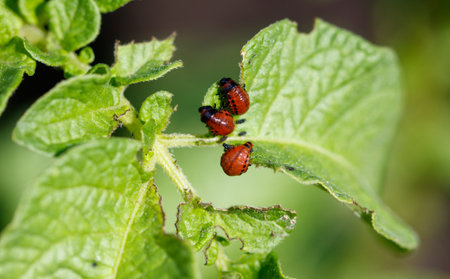Introduction to Natural Pest Prevention
American gardeners are increasingly turning toward eco-friendly pest control methods as a way to maintain healthy, vibrant gardens without compromising the environment. Natural pest prevention focuses on using organic and sustainable techniques that work in harmony with nature, rather than relying on synthetic chemicals. This approach not only protects pollinators like bees and butterflies but also supports soil health, water quality, and biodiversity. By favoring natural solutions, gardeners across the United States are helping to create safer outdoor spaces for families, pets, and local wildlife while still keeping troublesome pests at bay. As awareness of environmental issues grows, so does the popularity of these green gardening practices, making them a preferred choice for both novice and seasoned gardeners alike.
Spring: Kickstart Your Garden with Preventive Measures
As winter fades and temperatures begin to rise, spring is the ideal time for American gardeners to implement early pest prevention strategies. Taking action before pests become a problem helps ensure a healthy, bountiful garden throughout the season. Key springtime tactics include early interventions, companion planting, and physical barriers—each of which can play a crucial role in deterring emerging pests.
Early Interventions: Start Strong
Inspect your garden beds for overwintering insects and remove plant debris where pests might hide. Applying organic mulch not only retains soil moisture but also prevents weeds that can harbor pests. Using neem oil or insecticidal soap on susceptible young plants can stop infestations before they start.
Companion Planting: Nature’s Pest Repellent
Strategically placing certain plant combinations can naturally repel common garden pests. Here’s a quick reference table for popular American crops and their beneficial companions:
| Crop | Companion Plant | Pest Deterred |
|---|---|---|
| Tomatoes | Basil, Marigold | Aphids, Whiteflies |
| Cabbage | Dill, Nasturtium | Cabbageworms, Aphids |
| Carrots | Onions, Chives | Carrot Fly |
Physical Barriers: Shield Your Crops
Installing row covers or mesh screens over vulnerable seedlings can prevent flying insects from laying eggs. Raised beds and copper tape around the perimeter are effective against slugs and snails. Regularly check for holes or gaps in barriers to maintain their effectiveness.
Proactive Maintenance Tips
Keep your garden weed-free and rotate crops annually to disrupt pest life cycles. Monitor plants closely for early signs of damage and address issues immediately using natural solutions rather than chemical pesticides.

3. Summer: Managing Peak Pest Activity
As summer arrives, American gardens burst into full growth—and so do pests. This season is notorious for peak pest activity, making proactive and natural prevention strategies more important than ever. One of the most effective approaches is adopting organic sprays such as neem oil or insecticidal soap. These solutions target harmful bugs without posing risks to beneficial insects, pets, or people. Additionally, attracting and supporting beneficial insects like ladybugs, lacewings, and parasitic wasps can help keep pest populations in check. You can encourage these helpful allies by planting native flowers, providing water sources, and avoiding broad-spectrum pesticides that harm both good and bad bugs. Garden hygiene also plays a crucial role during the growing season; regularly remove plant debris, fallen fruit, and weeds to eliminate hiding spots and breeding grounds for pests. By combining these eco-friendly practices—organic treatments, fostering natural predators, and maintaining a clean garden—you’ll set up your landscape for a healthy, productive summer with fewer pest issues.
4. Fall: Garden Clean-Up and Reducing Overwintering Pests
As summer winds down and the harvest season wraps up, fall is a critical time for American gardeners to prepare their gardens for winter while minimizing future pest issues. Post-harvest garden maintenance plays a key role in interrupting the life cycles of many common pests that overwinter in plant debris or soil. By taking a few proactive steps, you can reduce the likelihood of facing heavy infestations when spring arrives.
Debris Removal: Your First Line of Defense
Fallen fruits, dead leaves, and leftover plant stems create cozy hiding spots for insect eggs, larvae, and disease pathogens. Removing this debris disrupts pest habitats and helps keep your garden healthier overall. Bag up plant residues instead of composting them if they show signs of pest activity or disease to avoid reintroducing problems next season.
Soil Amendments: Enrich and Protect
After cleaning up, improve your soil with organic matter such as compost or well-rotted manure. Not only does this nourish your plants for the following year, but it also supports beneficial soil microbes that compete with pests. Consider adding natural amendments that can deter pests, like neem seed meal or diatomaceous earth, especially around beds where you’ve had trouble before.
Fall Garden Tasks and Pest Prevention Benefits
| Task | Pest Prevention Benefit |
|---|---|
| Remove crop debris | Eliminates overwintering sites for insects and fungi |
| Add compost/manure | Boosts beneficial microbes that suppress soil-borne pests |
| Till soil lightly | Exposes pest larvae to predators and cold temperatures |
| Mulch clean beds | Prevents weed growth and stabilizes soil temperature |
By making fall clean-up a part of your annual gardening routine, you’ll not only enjoy tidier beds but also set the stage for a healthier, more resilient garden ecosystem come spring.
5. Winter: Preparing for Next Year
While winter may seem like a quiet time in the garden, it’s actually the perfect season for setting yourself up for natural pest prevention success next year. With your beds resting and most pests dormant, you have a window of opportunity to tackle essential off-season tasks that will pay off come spring.
Clean and Maintain Your Tools
Start by thoroughly cleaning all your gardening tools. Removing soil and plant debris from shovels, pruners, and other equipment helps prevent overwintering pests and diseases from hitching a ride into the new growing season. Disinfecting tools with a mild bleach solution or rubbing alcohol further reduces the risk of spreading pathogens when you start planting again.
Plan Crop Rotation Strategies
Winter is also prime time for planning your garden layout for the upcoming year. Crop rotation—changing where you plant different families of vegetables each year—breaks pest and disease cycles naturally. For example, moving tomatoes away from last year’s spot can help avoid soil-borne issues like nematodes or fungal spores that target nightshades. Sketch out your garden map now to ensure you’re maximizing this organic strategy.
Apply Dormant Oil Sprays
If you have fruit trees or ornamental shrubs, consider using dormant oil sprays during winter’s calm. These horticultural oils smother overwintering insect eggs and larvae without harming beneficial insects, since they’re not active in cold weather. Always follow label instructions, apply on mild days above freezing, and make sure plants are fully dormant to avoid damage.
Additional Off-Season Tasks
This is also a great time to clear away any remaining dead plant material and weeds that can harbor pests until spring. Compost healthy debris but discard anything showing signs of disease. You can also inspect garden structures like raised beds and fences for repairs, further reducing hiding spots for unwanted critters.
Set Yourself Up for Success
Taking these proactive steps in winter sets the stage for healthier plants and fewer pest problems in the coming year. With a little effort now, you’ll be ready to embrace organic gardening practices as soon as temperatures rise—giving your American garden its best chance for a productive, pest-resistant season ahead.
6. Top American Garden Pests and Their Natural Enemies
Every region in the U.S. has its own garden pest challenges, but there are some notorious bugs that nearly every American gardener battles. Fortunately, nature offers effective allies to help keep these pests in check—no harsh chemicals required! Below is a quick reference guide to the most common garden invaders and their natural enemies, so you can foster a balanced ecosystem right in your backyard.
Aphids
These tiny sap-suckers cluster on new growth and can quickly weaken plants. Natural predators: Ladybugs (lady beetles), lacewings, and hoverfly larvae are voracious aphid eaters. Planting dill, fennel, or yarrow will help attract these helpful insects.
Tomato Hornworms
Large green caterpillars that can strip tomato plants overnight. Natural predators: Parasitic wasps lay eggs inside hornworms, eventually killing them. Birds and predatory stink bugs also help control populations.
Japanese Beetles
Known for skeletonizing leaves, especially on roses and fruit trees. Natural predators: Tachinid flies and nematodes target beetle larvae in the soil; hand-picking adults into soapy water is also effective.
Slugs and Snails
Mollusks that leave holes in leafy greens and strawberries. Natural predators: Ground beetles, garter snakes, and birds love to snack on slugs. Encourage these allies by providing shelter like mulch or small stone piles.
Cabbage Loopers
Caterpillars that chew through cabbage, broccoli, and kale leaves. Natural predators: Trichogramma wasps parasitize looper eggs, while birds (especially chickadees) and predatory beetles feed on larvae.
Sustainable Tips for Success
To maximize natural pest control: diversify your plantings, avoid broad-spectrum pesticides that harm beneficial insects, and provide habitat for natural enemies by including native flowers and shrubs. By understanding which pests are likely to appear each season and encouraging their natural predators, you can enjoy a healthier, more resilient American garden—naturally!


